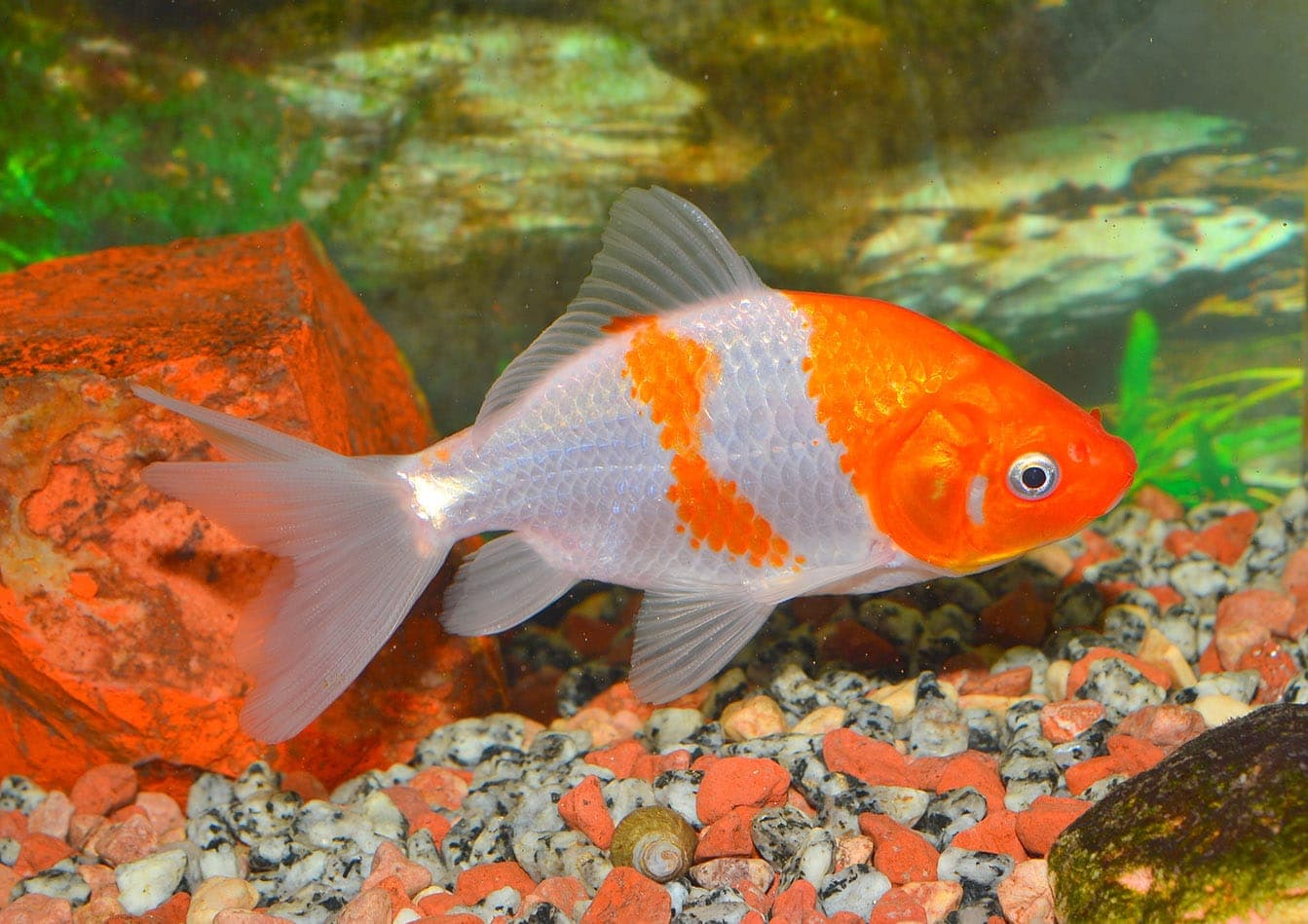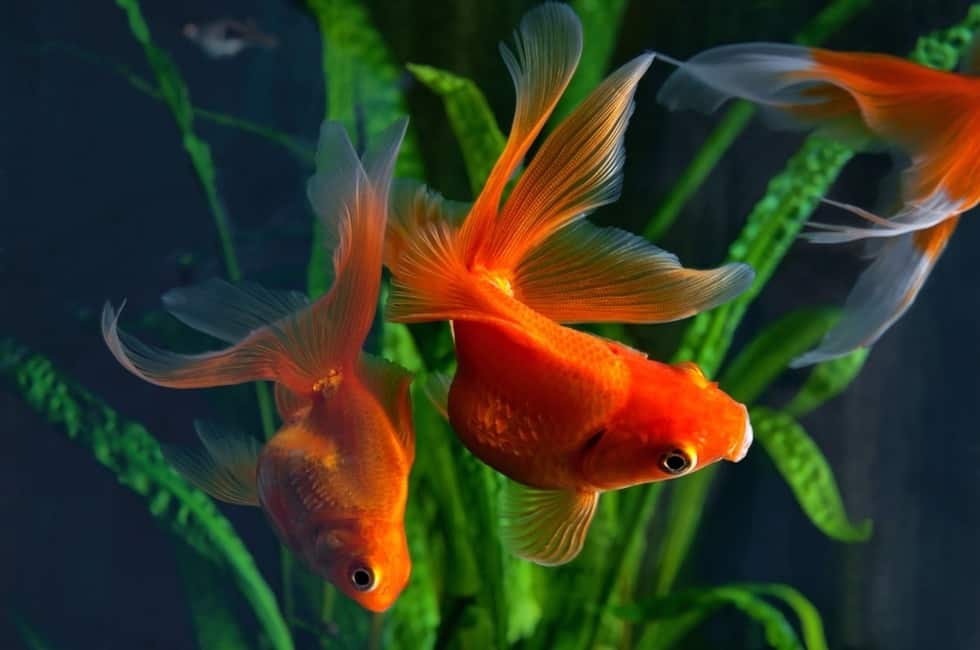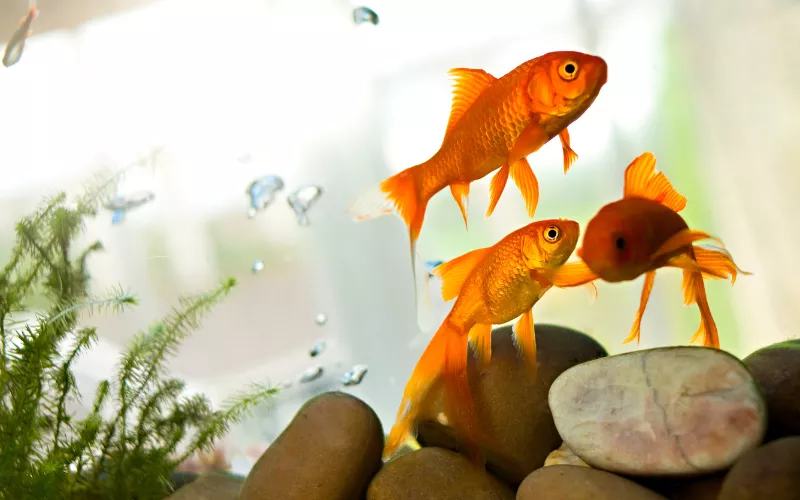Goldfish Water Temperature In Summer & Winter

Goldfish Water Temperature – Goldfish are widely popular as pet fish and can be found at almost all the stores in the country. In the world, Goldfish are considered the longest-living fish, with the highest age of 49.
Goldfish live up to 5 years if they are kept in small bowls, up to 10 years in aquariums and up to 20 years when kept in ponds, in some cases up to 40 years.
Maintaining their habitat is of utmost importance because they play a very crucial role. Goldfish prefer calm, slow-moving freshwater and sometimes cool water; therefore, they must not be kept in tropical aquariums.
Let’s know more about the goldfish water temperature that is most suitable for them. There are several factors that should be considered while keeping Goldfish which include area, soil, location, water availability, breed, etc. The most crucial of them all is water.
Water Temperature For Goldfish
Water temperature can affect fish to a great extent; wrong water can make them unhealthy, and hence they become prone to many diseases. What temperature of the water is best for goldfish?
The perfect goldfish water temperature is between 73-75 degrees F which is (23-24 degrees Centigrade). They can also live in temperatures of up to 30-degree centigrade, but it is advisable to keep them within the range.
In higher temperatures, there are chances that Goldfish become stressed.
Do Goldfish Prefer Warm Water?

Goldfish can resist a wide range of temperatures in outdoor ponds and aquariums because they are cold-water fishes. The Goldfish will swim slowly as compared to normal if the water is very cold and will not show much interest in any activity. In other words, it will reduce their performance level.
Goldfish will become prone to illness and many other diseases if the water is very warm. When Goldfish are kept within an average temperature range, they are very happy.
Goldfish Water Temperature – In Winter
Goldfish can stay in an outdoor pond only if the depth of the pond is deep enough that the water doesn’t get frozen, or else, Goldfish will freeze. If the depth of the pond is 4 feet, Goldfish will hide temporarily in order to survive through the winter.
Goldfishes are considered as robust fishes because they have the ability to survive the temperature of hard water, meaning during winter, they can survive in an indoor pond as long as water does not freeze, as they need enough oxygen and water.
The feed should also be taken into consideration for the survival of Goldfish during winter. Feed your Goldfish with cold water food when the temperature of the water falls below 15 degrees Celsius. But if the temperature of the water goes down, reduce their feed’s quantity.
It is advisable to stop feeding them if the temperature reaches 9 degrees Celsius because, at this point, their metabolism starts slowing down, and their digestive system stops processing the food, giving rise to food lodging within their guts, making them prone to various illnesses and diseases.

For estimating the water temperature, use a pond thermometer. It is advisable to keep the water temperature during winters within 60-75 Fahrenheit (16-24 degrees Celsius).
Remove trees or any other plants from the pond during winter as they will decompose, increase the level of nitrite and ammonia, and decrease the level of oxygen in the pond. If you want to prevent this, then the only way is to use pond nettings.
You can add cold water beneficial bacteria during winter as it is very effective. For example, Microbe-Lift Autumn Prep consists of enzymes that decompose any pond’s organic matter or residual leaves. In cold water, it will also help in sustaining biological activities.
During winter, the pond tends to freeze, so making a hole in the ice is very crucial for the survival of Goldfish. It will allow oxygen to get into the pond and release any unwanted gases from the pond. For this, you can make use of an aerator or pond heater.
Maintaining a suitable water temperature in winter is very important for keeping your Goldfish healthy and alive until spring.
Goldfish Water Temperature – In Summer
Goldfish perform well in aquariums if you maintain the tank’s water temperature during summer. You are also required to change the cold water often.
The Temperature around 70°F is best for the health of the Goldfish, and it should not go over 90°F.
In summer, warm water will stay on the surface (epilimnion), while cold water will remain at the bottom of the pond (hypolimnion).
Hypolimnion has more quantity of dissolved oxygen as compared to epilimnion. Therefore, do not get scared if your Goldfish stays at the bottom for most of the time, as oxygen is effortlessly available.
This will have a significant impact not only on Goldfish but also on other organisms because they will become incapable of surviving. Temperatures over (30°C/86°F) can harm the Goldfish.
Here are some tips to make your aquarium water cool:-
- Turn the aquarium water off.
- Avoid direct sunlight.
- Remove the tank lid.
- Place a fan close to the aquarium.
- Inside the water, place ice packs.
In summer, try to keep the aquarium cool, as rapid changes in the water temperature can be harmful to your fish.
What temperature is too cold for Goldfish?
Goldfish live in rivers, streams and cool lakes as they are cold-water fish. But it doesn’t mean that Goldfish can only be kept in cool water because when the water becomes too cold, your fish will stop eating and can even die.
For Goldfish, a water temperature below 50-55°F is considered too cold. After this, the Goldfish will go into hibernation or can even die. Therefore, it is crucial to manage and regulate the temperature of water by using a thermometer and pond heater.
How to achieve and check the desired water temperature?
Managing and checking the desired water temperature is vital for pond keeping. Winter and summer seasons can affect water temperature to a great extent, as water gets frozen in winter and warmer in summer.
Install a water thermometer to keep track and get genuine temperature readings. For measuring the surface temperature, use a floating water thermometer; for measuring the temperature of deeper areas, use a submersible thermometer. For higher accuracy, check the temperature in the morning, midday and night. After that, calculate the average.
Goldfish Tank Thermometers
Laguna Pond Celsius and Fahrenheit Scales thermometer
The Laguna thermometer is known as a floating device as it takes readings of the surface area. It can take readings both in Fahrenheit and Celsius. You can view the readings with the help of the transparent window and an indicator. This thermometer reads between 30-120°F. It is fish friendly and non-corrosive.
Adealink Mini Digital Thermometer
This is a digital thermometer which can take readings of deeper temperatures as compared to the floating thermometer. It is advisable for accuracy to take readings of different areas in the pond. Hold the study until the thermometer acquires a stable reading.
Dual Laser Digital Infrared Thermometer
It provides readings without the need to come in contact with water. You have to point it at the surface, accelerate the measurement trigger, and you will instantly get the readings. It also consists of convenient unit conversion operations that convert the units of Fahrenheit and Celsius.
Goldfish Tank Heaters
Titanium Aquarium Heater
This heater is made up of titanium, and therefore, it is corrosion-resistant, durable and lightweight. This heater can be used in medium and small-sized tanks. When the temperature of water achieves the “desired temperature”, the heater stops, and when the temperature of water goes 1°F less than the “set temperature”, it restarts heating. You only have to set the desired temperature, and that’s all.
Uniclife Submersible Aquarium Heater
This heater is positioned diagonally vertically instead of horizontally in the aquarium and should be immersed wholly. All you have to do is attach the suckers to the tank’s glass. With the help of a thermometer, you can monitor and maintain a desired temperature of water as it will affect the health of your fish directly by indicating with a blue line – the current temperature.
Changing The Tank Water
It is advisable that you should maintain a desired temperature within the specified range to keep your fish in good health. Adjust the temperature of water by 10 per hour as long as you get the appropriate temperature. Use a water conditioner when you are changing the water.
Sudden or frequent changes in the temperature of the water can cause temperature shock to your Goldfish. If it is extreme, then it can even kill the fish.
Symptoms of temperature shock include:
- Rapid breathing
- Floating aimlessly
- Sitting at the bottom
- Excess production of slime
- Surface gulping
After temperature fluctuations, you should use a filter bacteria supplement of good quality as it will help to re-establish the culture.
Conclusion
Goldfish live in rivers, streams and cool lakes as they are cold-water fish. But checking the temperature of the water is very crucial to make sure that the water is at the desired temperature and your Goldfish is comfortable. Keeping your Goldfish at a warm temperature will allow it to grow faster, increasing its metabolism and ultimately decreasing its lifespan. Goldfishes are robust as they get adjusted in several environments.
FAQs
Can Goldfish survive in 23 degrees of water?
The water temperature between 20°C – 23°C (68 °F – 74°F) is the perfect temperature for Goldfish. This temperature is high enough to encourage vigorous growth but without being so high that your fish become stressed by hot water and low oxygen levels.
Do Goldfish Prefer Warm or Cold Water?
Goldfish prefer cooler waters, between 62-74 degrees F and can resist a wide range of temperatures both in outdoor ponds and aquariums because they are cold-water fishes.
The Goldfish will swim slowly as compared to normal if the water is very cold and will not show much interest in any activity.
Goldfish will become prone to illness and many other diseases if the water is very warm. When Goldfish are kept within an average temperature range, they are very happy.
What is the desired PH level for Goldfish?
A goldfish can go through a vast PH range. The Goldfish cannot tolerate sudden or extreme changes in the level of PH. It is recommended that the desired PH range should be 6.0-8.0 for Goldfish. The Goldfish can endure water which is slightly alkaline or slightly acidic. For measuring the level of alkalinity and acidity, you can use a Ph metre.
What are the feeds of Goldfish?
The proper care of your Goldfish is closely linked to the amount and quality of food provided, as this significantly impacts your fish. Upon examining goldfish food, it was evident that it contains higher carbohydrate levels than alternative options, and its protein content is also comparatively lower than other fish diets.
Before settling on a food choice, several factors must be taken into account. These include their dimensions, the level of pollution, and the nutritional content. In their original environment, they consume vegetation, insects, and shellfish. You can also provide your Goldfish with nourishment that resembles what they would naturally find in their ecological niche.



